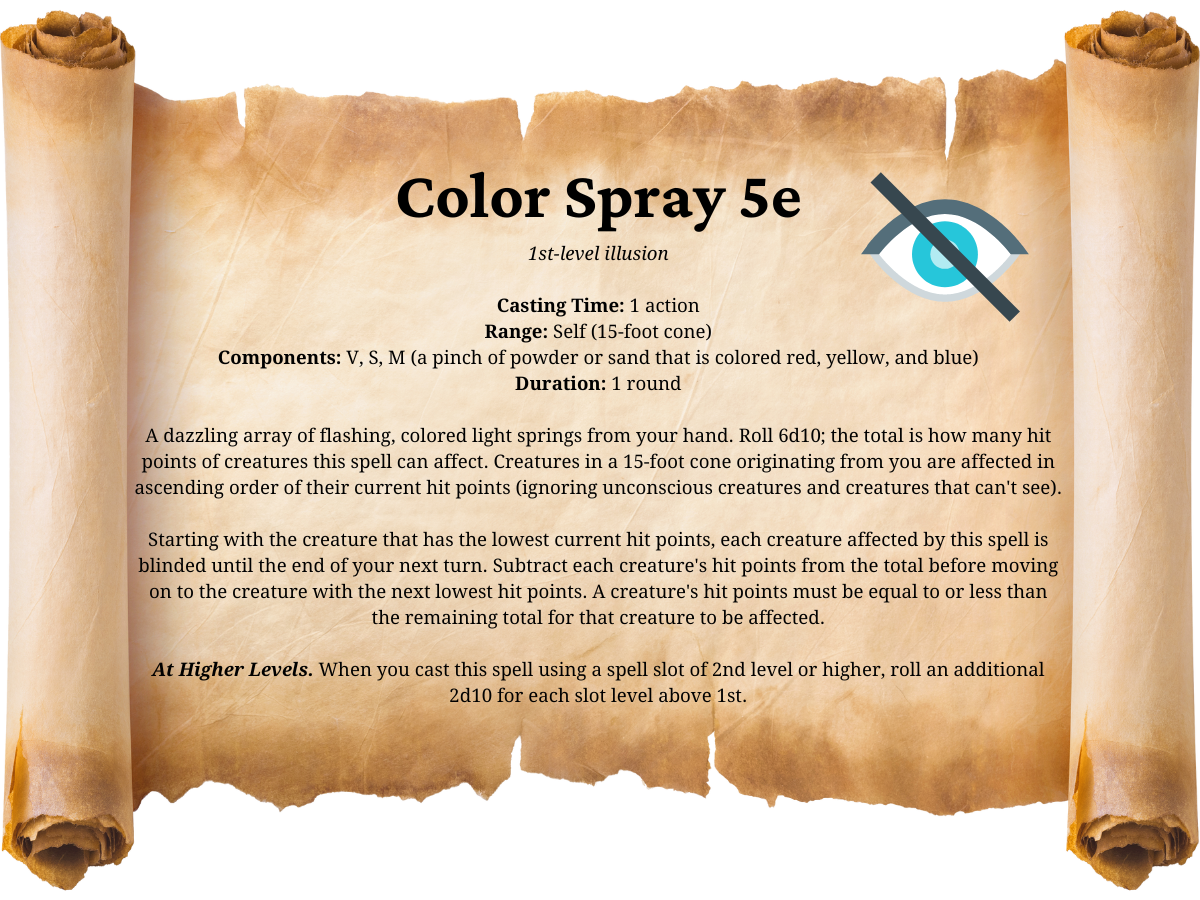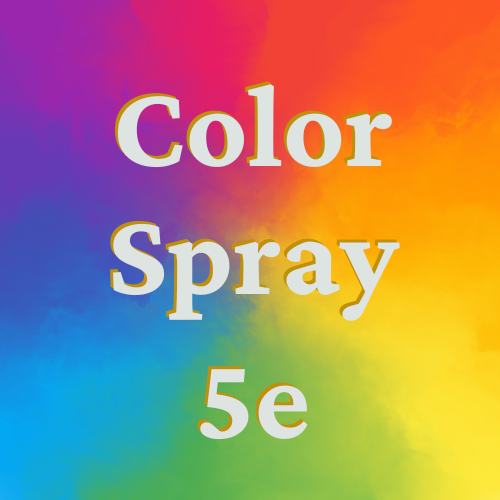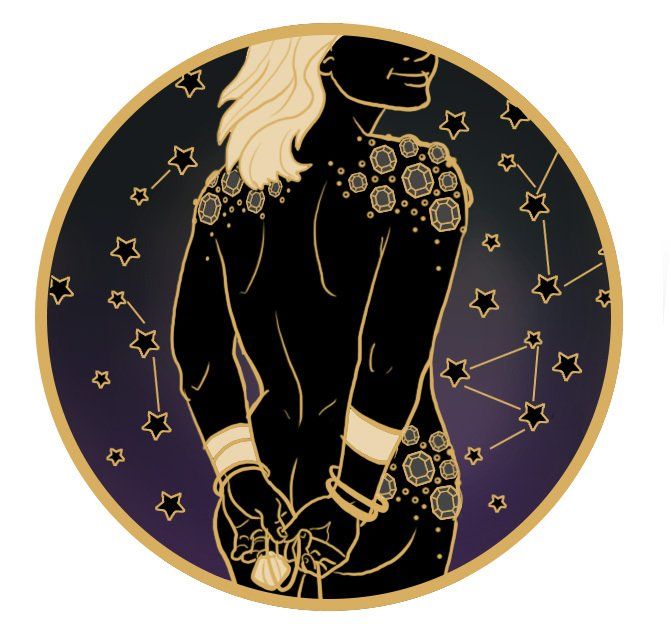Color Spray 5e - D&D 5th Edition Spell Book

Color Spray 5e Spell Effects
1st-level illusion
Casting Time: 1 action
Range: Self (15-foot cone)
Components: V, S, M (a pinch of powder or sand that is colored red, yellow, and blue)
Duration: 1 round
A dazzling array of flashing, colored light springs from your hand. Roll 6d10; the total is how many hit points of creatures this spell can affect. Creatures in a 15-foot cone originating from you are affected in ascending order of their current hit points (ignoring unconscious creatures and creatures that can't see).
Starting with the creature that has the lowest current hit points, each creature affected by this spell is blinded until the end of your next turn. Subtract each creature's hit points from the total before moving on to the creature with the next lowest hit points. A creature's hit points must be equal to or less than the remaining total for that creature to be affected.
At Higher Levels. When you cast this spell using a spell slot of 2nd level or higher, roll an additional 2d10 for each slot level above 1st.
All information on Color Spray 5e comes from the D&D 5th edition Player's Handbook.

Classes That Can Cast Color Spray 5e
The only classes from the player's handbook that may cast color spray 5e are the sorcerer and wizard. To me, color spray seems like the kind of spell that a bard would also be able to cast, but apparently the area of effect blinding status is a bit too powerful for them!
Color Spray 5e Spell Effectiveness
Instead of casting against saving throws or even using a ranged spell attack, color spray 5e automatically affects creatures up to the number that you roll on your 6d10 cast. However much your total roll is, that equals the number of "hit points" of creatures you can affect with color spray. So, the higher you roll, either the more creatures you can affect, or the stronger of creatures you can affect.
Color spray 5e is a blinding spell at its core, much like blindness deafness 5e, except that depending on the target creature's constitution save value, you may have better luck using this lower-level spell slot.
Blinded 5e
To make sure that you really understand exactly what the color spray 5e spell "does," the in-game status condition is officially called: "Blinded."
- A blinded creature can't see and automatically fails any ability check that requires sight.
- Attack rolls against the creature have advantage, and the creature's attack rolls have disadvantage.
Color Spray Usefulness
Color spray is basically an area of effect blind spell. The weaker your targets are, the more of them you can hit. However, even singular, very powerful foes can be almost automatically blinded for 1-round, so color spray certainly has utility in many situations.
It's worth noting that blinded creatures may still move towards you. They simply fail on sight-based ability checks, and they have disadvantage when making attack rolls, or when targeted by attack rolls. So, the usefulness of color spray 5e is really based on whether or not you're facing enemies who either deal a lot of physical damage, or who are primarily casting ranged spell attack-type spells, such as chromatic orb or chill touch 5e.
If an enemy were to simply use their turn with a dash action or were to cast a spell like cloud of daggers, blade ward 5e, or even cure wounds 5e, which do not rely on hit chance, then the blind effect would be essentially wasted.
Though powerful enemies may have access to such spells, numerous weaker enemies probably would not. In most cases, I've seen color spray 5e used to best effect, therefore, against crowds of relatively weak enemies, who all basically become significantly weaker for 1-round, while the blind effect takes place.
Visit the Eternity TTRPG Store!
Combine Color Spray 5e with the Following Spells
Since the main purpose of color spray 5e is to lower your targets' hit chance with physical or ranged spell attack-based attacks, anything you can do to bolster your defenses is a welcome addition to your blinding effect:
- Aid 5e: though this spell isn't a direct combination with color spray, whenever you're trying to keep yourself or allies alive, having temporary hit points - such as aid 5e provides - is always welcome.
- Armor of Agathys 5e: this spell also provides temporary hit points, though only for yourself. Additionally, effects that grant temporary hit points cannot stack, so you wouldn't be able to benefit from both this spell and aid 5e.
- Haste 5e: a sort of all-purpose spell, haste also raises your target's AC by +2, making it a natural combination with blinding enemies from color spray 5e.
- Mage Armor 5e: similar to haste, mage armor may increase your AC, so having it active provides another layer of protection.
Color Spray 5e Counters
Normally, an adventuring party of 4-or so players wouldn't be under too much threat from a spell like color spray 5e, since its blinding effect only lasts for 1-round. Players could easily maneuver themselves to take a more defensive stance for the 1-round duration, cast healing spells on themselves in the interim, or otherwise use their time in any number of other useful ways.
So, mostly it'll be enemy creatures (especially non spell casting creatures) who defend themselves against color spray. If an enemy has silence 5e, it of course, could prevent color spray 5e from ever being casted in the first place. However, color spray is probably the least of many enemy's worries. Additionally, they could use dispel magic on the effect, though using dispel on a
1-round blind probably seems like a waste.
As a sort of "soft counter," spells like Bless 5e could be cast, which raises attack rolls by +1d4, which could sort of offset the disadvantage to attack rolls from blindness.
Color Spray-Type Effects in Eternity TTRPG
When it comes to Eternity TTRPG, the actual "Blind" effect is pretty different from just some effect that lowers a target's hit chance. However, Blind is one of my personal favorite effects in the game, so I've included an example from the Thief class, below.

Thief - Core Class Ability
Darken:
Weapon Range, Strike Bonus vs. Resilience, Blind for 3turns. If you hit with this Ability, it also allows you to apply poisons that you have added to your Weapon.
(Double-Hit): Blind for an additional 3turns.
- (Saboteur) +7Strike Bonus vs. Resilience, Blind for 4turns.
- (Burglary) Move up to your Speed value +2 before or after using this Ability. You can also move up to your Speed value +2 before or after using this Ability, for Battle Duration.
- (Kleptomania) If this Ability hits, you also gain +6Strike Bonus specifically against the target.
Blind
While Blinded, a Character cannot use Abilities (though they may still cast Magic), and they have -6Strike Bonus when attacking. Abilities already in effect remain active even while a Character is Blinded.
In Eternity TTRPG, the blind effect not only reduces the target's physical hit chance, but it also prevents physical-based classes from using their spell-like effects (known as "Abilities"). Though Blind as a status condition does not also give the target disadvantage against attack rolls coming at them like it does in D&D, the "Kleptomania" critical option with the thief's "Darken" ability, above, does allow them to have additional hit chance against their blinded foe. This extra hit chance not only makes it easier for the thief to damage the enemy, but it also makes it easier for them to continually apply "Darken" (and blind) to the target.
Curious to learn more about the Eternity TTRPG Game System? Check out the
Eternity TTRPG Core Game PDF!
Dice, Dungeons, Games & More - Eternity TTRPG
Share This Article

Author - Jacob Tegtman
Dear reader, I hope you enjoyed this article. Tabletop gaming has been a passion of mine since I was 6 years old. I've played just about every game from Dungeons and Dragons to video games like Final Fantasy. These games have inspired me, made me laugh, made me cry, and brought me endless hours of enjoyment.
I started Eternity TTRPG - and the indie tabletop game that goes along with it (Eternity Shop) - to share my love of gaming with others. I believe that in our technology-driven age, tabletop games help bring a sense of magic and community back into our world.
If you love the site, please share it with others! I have lots of gaming-related material for you to peruse and use in your own gaming sessions. If you have any questions about the site or want to contribute, just send me a message using the "Contact" page, which you can find in the site's footer.










